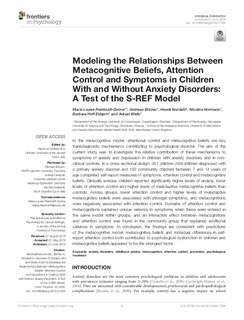| dc.contributor.author | Reinholdt-Dunne, Marie Louise | |
| dc.contributor.author | Blicher, Andreas | |
| dc.contributor.author | Nordahl, Henrik | |
| dc.contributor.author | Normann, Nicoline | |
| dc.contributor.author | Esbjørn, Barbara Hoff | |
| dc.contributor.author | Wells, Adrian | |
| dc.date.accessioned | 2019-06-11T05:57:51Z | |
| dc.date.available | 2019-06-11T05:57:51Z | |
| dc.date.created | 2019-06-09T16:21:18Z | |
| dc.date.issued | 2019 | |
| dc.identifier.citation | Frontiers in Psychology. 2019 | nb_NO |
| dc.identifier.issn | 1664-1078 | |
| dc.identifier.uri | http://hdl.handle.net/11250/2600396 | |
| dc.description.abstract | In the metacognitive model, attentional control and metacognitive beliefs are key transdiagnostic mechanisms contributing to psychological disorder. The aim of the current study was to investigate the relative contribution of these mechanisms to symptoms of anxiety and depression in children with anxiety disorders and in non-clinical controls. In a cross-sectional design, 351 children (169 children diagnosed with a primary anxiety disorder and 182 community children) between 7 and 14 years of age completed self-report measures of symptoms, attention control and metacognitive beliefs. Clinically anxious children reported significantly higher levels of anxiety, lower levels of attention control and higher levels of maladaptive metacognitive beliefs than controls. Across groups, lower attention control and higher levels of maladaptive metacognitive beliefs were associated with stronger symptoms, and metacognitions were negatively associated with attention control. Domains of attention control and metacognitions explained unique variance in symptoms when these were entered in the same model within groups, and an interaction effect between metacognitions and attention control was found in the community group that explained additional variance in symptoms. In conclusion, the findings are consistent with predictions of the metacognitive model; metacognitive beliefs and individual differences in self-report attention control both contributed to psychological dysfunction in children and metacognitive beliefs appeared to be the strongest factor. | nb_NO |
| dc.language.iso | eng | nb_NO |
| dc.publisher | Frontiers Media | nb_NO |
| dc.rights | Navngivelse 4.0 Internasjonal | * |
| dc.rights.uri | http://creativecommons.org/licenses/by/4.0/deed.no | * |
| dc.title | Modeling the Relationships Between Metacognitive Beliefs, Attention Control and Symptoms in Children With and Without Anxiety Disorders: A Test of the S-REF Model | nb_NO |
| dc.type | Journal article | nb_NO |
| dc.type | Peer reviewed | nb_NO |
| dc.description.version | publishedVersion | nb_NO |
| dc.source.journal | Frontiers in Psychology | nb_NO |
| dc.identifier.doi | https://doi.org/10.3389/fpsyg.2019.01205 | |
| dc.identifier.cristin | 1703662 | |
| dc.description.localcode | Copyright © 2019 Reinholdt-Dunne, Blicher, Nordahl, Normann, Esbjørn and Wells. This is an open-access article distributed under the terms of the Creative Commons Attribution License (CC BY). | nb_NO |
| cristin.unitcode | 194,67,40,0 | |
| cristin.unitname | Institutt for psykologi | |
| cristin.ispublished | true | |
| cristin.fulltext | original | |
| cristin.qualitycode | 2 | |

